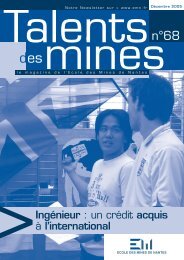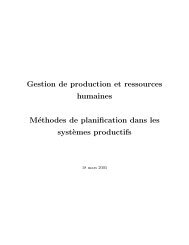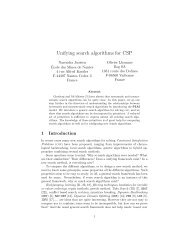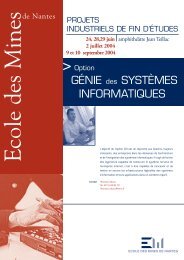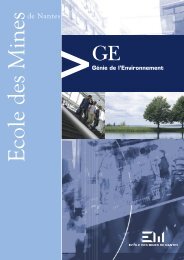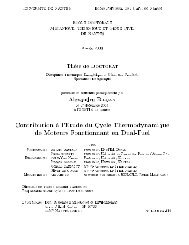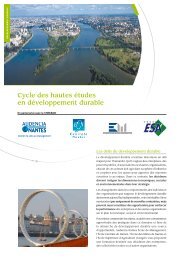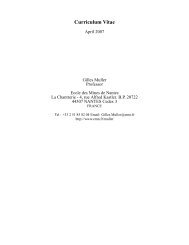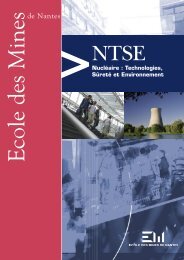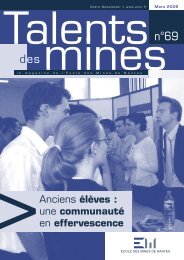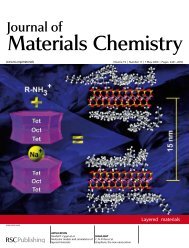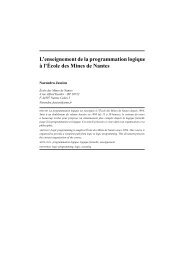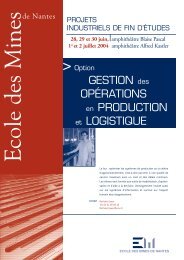pdf - 395 K - Ecole des mines de Nantes
pdf - 395 K - Ecole des mines de Nantes
pdf - 395 K - Ecole des mines de Nantes
You also want an ePaper? Increase the reach of your titles
YUMPU automatically turns print PDFs into web optimized ePapers that Google loves.
very large repositories of learning objects. In this section we<strong><strong>de</strong>s</strong>cribe the case study in which this problem appears.Technological advances in the past few years, particularly inthe area of online <strong>de</strong>livery and e-learning, have inspiredchanges in the way educational materials are <strong><strong>de</strong>s</strong>igned,<strong>de</strong>veloped, and <strong>de</strong>livered to teachers and stu<strong>de</strong>nts. A majorshift in educational materials <strong>de</strong>velopment has occurred wherethere is a move away from the traditional method of <strong>de</strong>velopingcourses in an integrated way to accomplish a learningobjective to one that is based on the use of individual buildingblocks or bite-sized “learning objects” [8]. This approachresembles what Wayne Hodgins, Director of Worldwi<strong>de</strong>Learning Solutions, has called the Legos TM approach. In thesame way that Legos TM building blocks can be used to build avariety of structures, so too learning objects can be used bylecturers, teachers and others in creative ways to build courseswhich meet different learning outcomes. The theoreticalun<strong>de</strong>rpinning is that instead of thousands of people wastingtime “re-inventing the wheel”, a learning object onceconstructed can be re-used and shared. Steven Downs [9] hasargued that the economics of sharing learning objects arerelentless.This new approach has resulted in the establishment of alarge number of learning object repositories both withinAustralia and overseas.While theoretical un<strong>de</strong>rpinnings of learning objectrepositories are difficult to challenge, a number of issuesrelating to their establishment still need to be researched. Ourproject will address major problems/issues, such as the lack ofconsultation/analysis of user needs in the creation ofrepositories and ina<strong>de</strong>quate resource dis covery tools. It hasbeen reported that many of the learning repositories aredifficult to use.We will try to address these problems:- by un<strong>de</strong>rtaking user needs and usages analysis, and byusing the data collected by the multi-agent component(see fig.1);- by facilitating access to the plethora of contentrepositories and to address the problems of locating,exploring and manipulating learning resources expertlyand creatively;- by using the Learning Object Exploration System, crossdomainsearching software and profiling systems toautomatically match the needs of users with theappropriate learning objects;- by using “intelligent” agents to “remember” frequentlyused and relevant resources and to inform usersthrough presenting more intelligently gui<strong>de</strong>d pathwayswithin that virtual environment.The project will <strong>de</strong>liver an intelligent Learning ObjectExploration System capable of i<strong>de</strong>ntifying the needs ofteachers, lecturers and course buil<strong>de</strong>rs. This “intelligence” willbe based on “profiling”, extensive user analysis and resourceassessment, and the construction of an “intelligent” agents toprovi<strong>de</strong> appropriate feedback.The <strong>de</strong>velopment of an intelligent learning architectureincorporates:- the ability to actively collect and access a wi<strong>de</strong> rangeof content repositories- substantial improvements in the usefulness oflearning objects within any given repository leadingto enhanced exploitation of learning materials .- the provision of enhanced feedback for the bettermanagement of content repositories.III. MULTI-AGENT ARCHITECTUREIn this section we <strong><strong>de</strong>s</strong>cribe this architecture. An overall viewof the architecture is <strong>de</strong>picted in Fig.1.userInteracts withLearning Objects ExplorationSystemWebBrowserCommunicates withWebServerGives access toLearningObjectRepositoryLearningObjectProvi<strong><strong>de</strong>s</strong> exploration assistancePlugs web contentsWritesLogLearningObjectReadsBusiness IntelligenceComponentArchitectureAccessesExplorationSystem InterfaceFig. 1. Overview of the whole systemAccessesStandard UserProfilesReadsAgents ComponentUser AgentsComponentNo<strong>de</strong> AgentsComponentThe prototype is based on an agent infrastructure and agentframework <strong>de</strong>veloped in C#. The infrastructure supports multihostsdistribution via .Net’s remoting and MSMQ. PersistentMSc EMOOSE Thesis – http://www.emn.fr/EMOOSE 61



